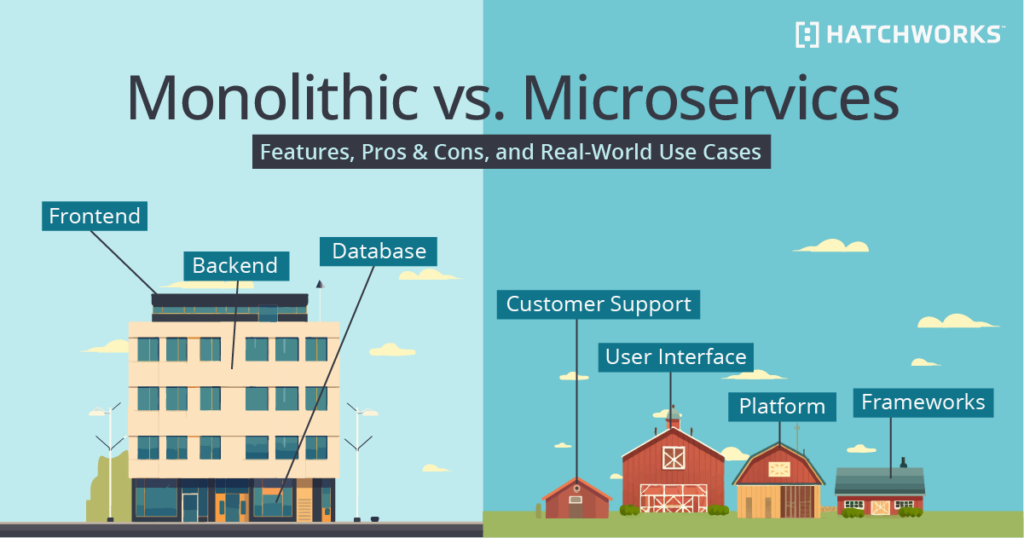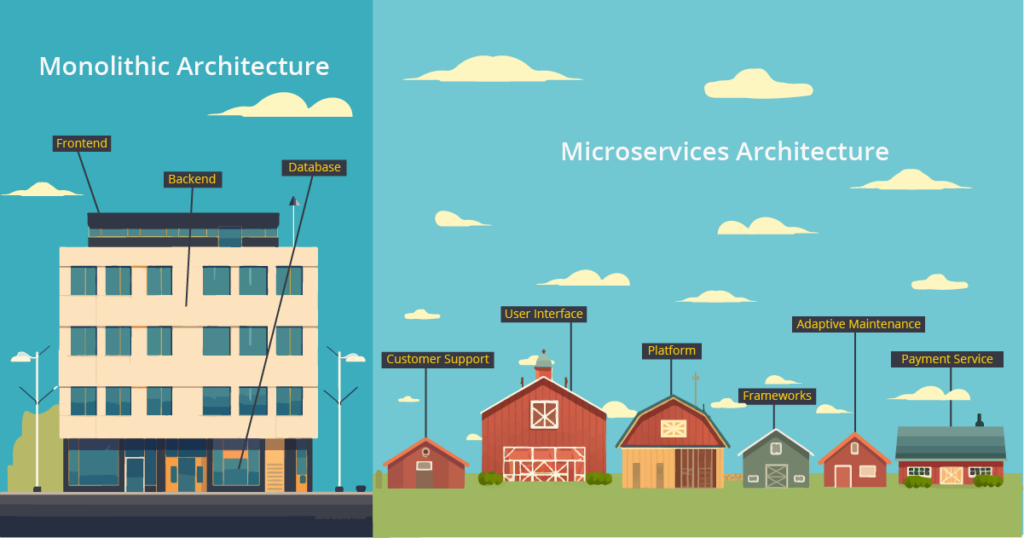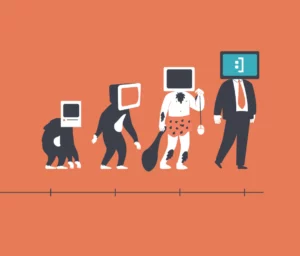A new software project sits before you. But before your team builds it, you need to choose the architecture.
It’s a simple yet strategic choice which comes down to monolithic vs microservices architecture.
Do you go monolithic to keep it simple with your small team? Or do you take the time to build a microservices architecture that will scale with the needs of the business?
To truly know if monolithic or microservices architecture is right for your software needs, you need to have a clear understanding of what they are, how they’re used, and when they work best.

What is Monolithic Architecture?
In monolithic architectures, all parts of the application are united through a single codebase.
This means that different components of the application, such as the user interface, server-side logic, database operations, and application integration, are all part of a single software unit.
To change one component, you must alter that singular code base and update the entire system.
Core Characteristics of Monolithic Architecture:
- Unified Codebase: The entire application is developed, deployed, and scaled as a single unit.
- Simplicity in Development and Deployment: Easier to develop and deploy initially since everything is contained in one codebase.
- Scalability Challenges: Scaling requires scaling the entire application, not just the parts that need it.
- Reliability Concerns: A bug in any part of the application can potentially bring down the entire system.
Best For: Small, simple applications or when rapid application development is needed.
What is Microservices Architecture?
Microservices architecture breaks down an application into a collection of smaller, interconnected services.
Each service is focused on a specific business function and can be developed, deployed, and scaled independently.
You can change parts of the application individually without interrupting the structure of other software components because it is a distributed system. These components ‘talk’ to each other using API’s so that the software can work as one despite operating individually.
With microservice architecture, you have a complex and scalable application.
Core Characteristics of Microservices Architecture:
- Decentralized and Modular: Services are loosely coupled and can be developed and maintained independently.
- Scalability: Individual services can be scaled as needed, which is more efficient and cost-effective.
- Resilience: Failure in one service doesn’t necessarily bring down the entire application.
- Complexity in Management: Requires more effort in terms of coordination, communication, and infrastructure management.
Best For: Large, complex applications, especially those requiring high scalability and flexibility.
📕Further reading: Why Your Organization Needs Microservices
Structural Differences Between Monolithic and Microservices Architecture
The structure of a software architecture determines how its components interact and function together.
Think of monolithic architecture as a single-block structure where every part of the application is interconnected. In fact, you can think of it like one large building.
Everything, from the living room to the dining area, is housed under one roof. This architecture is unified and cohesive, with all components – frontend, backend, and database – tightly interwoven.
While this integration simplifies initial development and deployment, it can also create a domino effect where an issue in one area can impact the entire structure.

Microservices architecture, on the other hand, is like a farm with several outbuildings that each serve a unique purpose.
Each ‘outbuilding’ is one of several independent services and is responsible for a specific function. This separation allows for flexibility and targeted updates without disrupting the entire system.
Services communicate with each other but remain loosely coupled, meaning changes or failures in one service have minimal impact on others. This structure excels in complex, evolving environments but requires a robust network of communication and coordination.
But what is the impact of these structural differences on software performance and scalability?
Performance and Scalability of Monolithic and Microservices Architecture
Performance-wise, monolithic architectures are fast and efficient for small-scale applications.
However, as the application grows, this architecture can slow down, struggling under increased load. Scaling up means beefing up the entire system, even if only one part needs it. It’s like having to renovate an entire building just to expand one room.
Microservices excel in scalability because the setup allows for specific areas to be developed or scaled back as needed, ensuring efficient use of resources and quick adaptation to changing demands.
If you think back to our farm outbuildings, you’re able to update the chicken coop without disrupting the stables.
However, it comes with the complexity of managing multiple independent structures, which can impact overall performance if not coordinated effectively.
| Monolithic Architecture | Microservices Architecture |
|---|---|
|
Performs well for small-scale applications.
|
Performs well with careful management.
|
|
Scaling Limitations:
|
Independent Scaling:
|
|
Resource-Intensive Scaling:
|
Complexity in Management:
|
Advantages and Disadvantages
Here’s a quick breakdown of the pros and cons of monolithic and microservices architectures:Pros and Cons of Monolithic Architecture
Pros- Simplicity in Development and Deployment: Monolithic architecture is straightforward to develop, test, and deploy, especially for small-scale applications.
- Ease of Debugging and Testing: Since all components are under one roof, tracking bugs and testing the application is more straightforward.
- Initial Cost-Effectiveness: Starting with a monolithic architecture often requires less investment in both infrastructure and human resources.
- Scalability Issues: Scaling a monolithic application can be challenging, as it involves scaling the entire application rather than individual components.
- Difficulty in Adopting New Technologies: Integrating new technologies or making significant changes can be complex and risky.
- Risk of Downtime: A single point of failure in any part of the application can potentially bring down the entire system.
Pros and Cons of Microservices Architecture
Pros- Scalability and Flexibility: Microservices excel in scalability, allowing individual components to be scaled as needed.
- Isolated failures: Failures are isolated within a single service, reducing the risk of system-wide crashes.
- Ease of Integrating New Technologies: Microservices allow for easier adoption of new technologies within different services.
- Complexity in Management: Orchestrating numerous services can be challenging.
- Higher Operational Costs: Microservices require more infrastructure and resources, leading to higher operational costs.
- Network Latency and Communication Overhead: Inter-service communication over the network can introduce latency and complexity.
Choosing Between Monolithic and Microservices: Factors to Consider
When choosing between monolithic and microservices architectures you need to consider:
- your specific project needs
- business capabilities
- team dynamics and resources
- and future scalability
But even these can be divided into further factors. Below, we’ve outlined eight factors that should inform your decision.
Project Size and Complexity:
How large is the project you’re working on and how complex does the software need to be?
- Monolithic: Ideal for small to medium-sized projects with a well-defined scope.
- Microservices: Better for large, complex projects with multiple, evolving components.
Team Expertise and Resources:
Do you have in-house talent with the skills required to build microservices architecture?
Are you willing to outsource to someone with that talent (through Nearshore Software Development or another outsourcing model)?
Or are you better off starting with a simpler monolithic architecture to start?
- Monolithic: Requires standard software development skills, making it a good fit if your team is not familiar with the complexities of microservices.
- Microservices: Demands expertise in distributed systems, microservices patterns, and DevOps practices. Ensure your team has the skills or is ready to upskill.
Development and Maintenance Costs:
How much time and money can you dedicate and want to dedicate to this software project right now?
Are you prepared to continuously invest in it or do you want to spend less on it over time?
- Monolithic: Generally, less expensive and quicker to develop initially but can become cumbersome to maintain as it grows.
- Microservices: Higher initial investment in development and infrastructure but can be more cost-effective in the long run due to easier maintenance and scalability.
Scalability and Performance Needs:
How much will this software project need to change over time?
Will a monolithic architecture be able to handle an increased load or will you need to change the architecture to microservices down the line?
Is that a change you’re comfortable investing in later or should you build a microservices architecture to start if you have the capabilities and financial resources now?
- Monolithic: Scaling means scaling the entire application, which can be resource-intensive.
- Microservices: Allows for scaling individual components as needed, providing efficient resource utilization and better handling of high loads in a complex system.
Time to Market:
How quickly do you need this software built?
- Monolithic: Quicker to develop and deploy initially, which can be crucial for startups or when launching new products.
- Microservices: May take longer to set up due to its complexity but offers faster iteration and deployment once operational.
Top tip: If you need work completed quickly, want to prioritize scalability, and have the financial resources to build microservices but lack in-house capabilities, you can use Nearshore Software Development.
Flexibility and Adaptability:
Will you need to adjust the software over time, and when you do is it okay if the entire software is paused while updates are made?
- Monolithic: Less flexible in adapting to changes or new technologies.
- Microservices: Highly adaptable to changes, making it easier to integrate new technologies and make updates. Business logic is spread across each service so that if one system is disrupted, the other services remain intact.
Risk and Reliability:
How important is the software to business or product operation?
- Monolithic: A failure in one part of the application can affect the entire system.
- Microservices: Better fault isolation, where an issue in one service has minimal impact on others.
Organizational Structure:
Who is the decision maker in your organization? Is there more than one? How do they come to decisions? Do you want to encourage more autonomy amongst teams?
- Monolithic: Well-suited for smaller teams or organizations with centralized decision-making.
- Microservices: Aligns well with larger, distributed teams and encourages decentralized decision-making.
When to Choose Monolithic Architecture
Choose monolithic architecture when you have:
- Small to Medium-Sized Projects: Ideal for projects with limited scope where simplicity and quick deployment are priorities.
- Limited Resources and Expertise: If your team is not equipped to handle the complexity of microservices, a monolithic approach is more manageable.
- Rapid Prototyping: When speed is key, and you need to test a concept quickly, the unified nature of monolithic architecture can be beneficial.
Example Case:
Consider a startup developing its first web application. With a small team and limited budget, a monolithic architecture allows them to quickly build and iterate, focusing on core features without the overhead of coordinating multiple services.
When to Opt for Microservices Architecture
Choose microservices architecture when you have:- Large, Complex Applications: When your application has multiple, distinct components that require independent scaling and updating.
- High Scalability Needs: If you anticipate a need to scale specific parts of your application due to varying loads, microservices offer that flexibility.
- Distributed Teams and Advanced DevOps Practices: Teams spread across locations can work independently on different services, and advanced DevOps practices can manage the complexity.
Real-World Use Cases and Applications
Netflix: A Microservices Architecture Example
Netflix, one of the world’s leading streaming entertainment services, transitioned from a monolithic to a microservices architecture. This move was crucial to handle their rapidly growing user base and the increasing demand for their services.
Netflix’s adoption of microservices represents a shift from a one-size-fits-all monolithic architecture to a more flexible, scalable, and resilient system. It’s an excellent example of how microservices can support the needs of a large, dynamic, and customer-focused online service. This architecture has played a significant role in Netflix’s ability to provide a high-quality, reliable streaming experience to millions of users worldwide.
How It Works:
Decomposition of Services:
Netflix’s application is broken down into hundreds of microservices. Each service manages a specific function of the application. For example, one service handles user profiles, another manages video recommendations, and yet another is responsible for processing payments.
Independent Development and Deployment:
These services are developed and deployed independently. This means the team working on the recommendation system can update their service without having to coordinate with the team handling user profiles.
Scalability:
During peak hours, when millions of users are streaming content, Netflix can scale up the services handling content delivery and streaming without having to scale the entire application. This targeted scalability is efficient and cost-effective.
Resilience:
The microservices architecture also enhances the resilience of the system. If one service fails, for instance, the payment processing service, it won’t bring down the entire application. Users might not be able to make new payments temporarily, but they can still stream content uninterrupted.
Continuous Deployment and Experimentation:
Netflix constantly tests new features and improvements in its services. Microservices allow for continuous deployment and A/B testing, enabling rapid innovation and adaptation to user preferences.
Amazon: A Monolithic Architecture Example
In its early years, Amazon’s online retail platform was developed as a monolithic application. At that time, the company’s primary focus was on establishing an online bookstore, which later expanded to include a wide range of products and services.
How It Worked:
Unified Structure:
All components of Amazon’s platform, including user interface, product listings, order processing, and customer management, were part of a single, interconnected and interdependent codebase.
Centralized Database:
The platform used a centralized database to store all data, which meant that every part of the application interacted with this database for all operations.
Simplicity and Initial Efficiency:
Initially, this monolithic approach was advantageous for Amazon. It allowed for straightforward development and deployment, as everything was centralized and there were fewer complexities in terms of inter-service communication.
Challenges with Growth:
As Amazon grew, the limitations of the monolithic architecture became apparent. The platform struggled with scalability, and making updates or changes became increasingly complex and risky. Any modification required redeploying the entire platform, which could introduce bugs and downtime.
Transitioning to Microservices:
Recognizing these challenges, Amazon eventually transitioned to a microservices architecture. This shift allowed Amazon to scale its services more efficiently, deploy updates faster, and reduce the risk of system-wide failures.
Amazon’s initial use of monolithic architecture is a testament to its simplicity and effectiveness for startups and small-scale applications. However, as the company grew, the need for a more scalable, flexible, and resilient architecture became evident, leading to their shift towards microservices. This example illustrates the typical journey of many businesses: starting with a monolithic architecture for its straightforward setup and eventually migrating to microservices as the business scales and the demand for agility and innovation increases.
But that doesn’t mean there aren’t still benefits to operating with a monolithic architecture. In 2023, Amazon Prime made waves when its Dev team reverted back to a monolithic structure.
Transform Workflows into 24/7 AI Engines
Let Agentic AI Automation take the wheel—boosting speed, accuracy, and ROI at scale.



